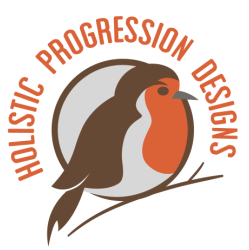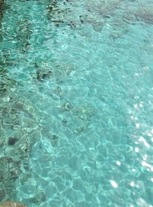
The Mediterranean region is one of the most affected areas of climate change. Water deficit, soil erosion, pollution, forest over-exploitation and loss of natural habitats are some of the main environmental challenges you and your land are likely to face if you live in this region.
However, as any Permaculturist would tell you, the problem is the solution. Permaculture takes these challenges and, through design and specific strategies, transforms them into solutions. Affordable and accessible solutions! That’s what makes Permaculture so interesting and empowering.
The success of land based projects will depend on how the inherent challenges of being located in the Mediterranean region are tackled. If you have land or plan to have land in a Mediterranean country and would like to transform it into a thriving project or home, read on as this will surely interest you.
However, as any Permaculturist would tell you, the problem is the solution. Permaculture takes these challenges and, through design and specific strategies, transforms them into solutions. Affordable and accessible solutions! That’s what makes Permaculture so interesting and empowering.
The success of land based projects will depend on how the inherent challenges of being located in the Mediterranean region are tackled. If you have land or plan to have land in a Mediterranean country and would like to transform it into a thriving project or home, read on as this will surely interest you.
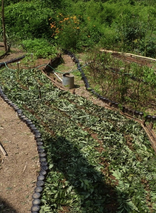
Five ways of managing water wisely, from a Permaculture perspective:
1. Reduce the use of water in agriculture
The Mediterranean has a long growing season and hot summers. Water is a valuable resource and, by using it carefully, you can make your water go further, save yourself time and money as well as increase biodiversity and resilience while producing higher yields. There are several things that I always recommend:
1. Water in the evening. This greatly reduces evaporation and allows the plants to slowly take in the water through the night.
2. Add thick layers of seedless mulch on top of the soil around but not touching trees and plants. There are many benefits to adding a layer of organic matter on top of the soil: It reduces undesired plants (weeds), evaporation, sun and rain erosion, regulates temperature and adds to the soil composition. Bare soil is unhealthy soil and is almost never seen in nature.
3. Use drip lines placed under the mulch, which will extend the life of the drip line.
4. Plan and design to grow crops in shade during the height of summer and select drought resistant crops if you have limited access to water.
1. Reduce the use of water in agriculture
The Mediterranean has a long growing season and hot summers. Water is a valuable resource and, by using it carefully, you can make your water go further, save yourself time and money as well as increase biodiversity and resilience while producing higher yields. There are several things that I always recommend:
1. Water in the evening. This greatly reduces evaporation and allows the plants to slowly take in the water through the night.
2. Add thick layers of seedless mulch on top of the soil around but not touching trees and plants. There are many benefits to adding a layer of organic matter on top of the soil: It reduces undesired plants (weeds), evaporation, sun and rain erosion, regulates temperature and adds to the soil composition. Bare soil is unhealthy soil and is almost never seen in nature.
3. Use drip lines placed under the mulch, which will extend the life of the drip line.
4. Plan and design to grow crops in shade during the height of summer and select drought resistant crops if you have limited access to water.
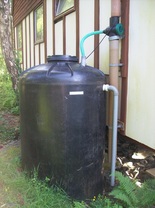
2. Harvest rain water from roofs
It is relatively easy and inexpensive to collect rain water from the roofs of all structures on a property. This can be done by channeling it through gutters and down pipes to water tanks. It is indeed one of the most simple ways of harvesting large volumes of water. The overflow from the tanks can go to vegetable production systems and swales designed with that purpose in mind. Water stored in tanks can be used for the majority of the project's water needs and can act as a valuable back up. Depending on needs and budget, tanks can vary in size and materials. Water can also be harvested from other hard surfaces like rocky areas and roads. The surface material of roads will directly impact the quality of the water and how it is used.
It is relatively easy and inexpensive to collect rain water from the roofs of all structures on a property. This can be done by channeling it through gutters and down pipes to water tanks. It is indeed one of the most simple ways of harvesting large volumes of water. The overflow from the tanks can go to vegetable production systems and swales designed with that purpose in mind. Water stored in tanks can be used for the majority of the project's water needs and can act as a valuable back up. Depending on needs and budget, tanks can vary in size and materials. Water can also be harvested from other hard surfaces like rocky areas and roads. The surface material of roads will directly impact the quality of the water and how it is used.
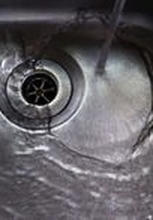
3. Treat and reuse your grey water
Grey water is water from sinks, baths, showers and washing machines. There is a huge opportunity to reuse grey water from buildings. To do so, there is a range of systems that vary in complexity. Grey water treatment systems enable the reuse of water for irrigation of crops and trees. Having slope is obviously an advantage as the use gravity reduces the need for pumps.
An example of one grey water purification system that I designed for a client has eight stages. The water passes through a process mimicking a natural system and it is slowed at each stage to provide proper purification.
Grey water is water from sinks, baths, showers and washing machines. There is a huge opportunity to reuse grey water from buildings. To do so, there is a range of systems that vary in complexity. Grey water treatment systems enable the reuse of water for irrigation of crops and trees. Having slope is obviously an advantage as the use gravity reduces the need for pumps.
An example of one grey water purification system that I designed for a client has eight stages. The water passes through a process mimicking a natural system and it is slowed at each stage to provide proper purification.
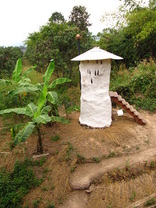
4. Composting toilets
Out of all the water on earth only 1% of 1% is easily available for human use. The amount of water available per person is decreasing as global population rises. Yet much of the Mediterranean's human waste is mixed with drinking quality water and flushed away without a second thought. This takes a lot of energy to process and cleanse that water.
We can view our waste as a resource and at the same time save huge amounts of energy and drinking quality water, especially in regions with high water deficit like the Mediterranean. Composting toilets demonstrate how to convert our waste and returning it back to the earth in the form of high quality compost. This contributes to the energetic autonomy of a project, while reducing the misuse of water. Composting toilets are a great solution and work well at projects that receive large numbers of guests.
Out of all the water on earth only 1% of 1% is easily available for human use. The amount of water available per person is decreasing as global population rises. Yet much of the Mediterranean's human waste is mixed with drinking quality water and flushed away without a second thought. This takes a lot of energy to process and cleanse that water.
We can view our waste as a resource and at the same time save huge amounts of energy and drinking quality water, especially in regions with high water deficit like the Mediterranean. Composting toilets demonstrate how to convert our waste and returning it back to the earth in the form of high quality compost. This contributes to the energetic autonomy of a project, while reducing the misuse of water. Composting toilets are a great solution and work well at projects that receive large numbers of guests.
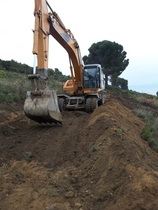
5. Invest resources creating ponds and swales
This is big picture design and has many benefits, especially when implemented in the early stages of a project's development, as demonstrated in this blog post. The need for such earth works will depend on the holistic goals of the project, soil type, resources available and the topography of the land.
Ponds and dams are the cheapest and most efficient way of storing large volumes of easily accessible water and can multi-function as natural swimming pools and aquaculture systems.
Swales are water harvesting ditches on contour, often created in combination with ponds / dams. Swales work well when you have a site that has slope up to 15% and potential for erosion from rains. Soil erosion is a major problem globally, often worsened when combined with ”conventional agricultural” practices.
Swales stop and pacify over land flows of water during rains, harvesting and holding the water on contour and allowing it to slowly percolate in to the ground. This benefits the trees and plants placed on the berm down hill from the swale. Soil is the largest and cheapest water storage when water is allowed to absorb.
This is big picture design and has many benefits, especially when implemented in the early stages of a project's development, as demonstrated in this blog post. The need for such earth works will depend on the holistic goals of the project, soil type, resources available and the topography of the land.
Ponds and dams are the cheapest and most efficient way of storing large volumes of easily accessible water and can multi-function as natural swimming pools and aquaculture systems.
Swales are water harvesting ditches on contour, often created in combination with ponds / dams. Swales work well when you have a site that has slope up to 15% and potential for erosion from rains. Soil erosion is a major problem globally, often worsened when combined with ”conventional agricultural” practices.
Swales stop and pacify over land flows of water during rains, harvesting and holding the water on contour and allowing it to slowly percolate in to the ground. This benefits the trees and plants placed on the berm down hill from the swale. Soil is the largest and cheapest water storage when water is allowed to absorb.
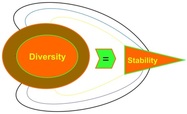
Diversity brings stability
Each important function is supported by many elements. This is one of Bill Mollison’s Permaculture principles. Having important functions supported by multiple elements creates resilience by having several back ups in place. In the case of water, especially in the Mediterranean, this is essential.
Matt Prosser 10.03.2016
Each important function is supported by many elements. This is one of Bill Mollison’s Permaculture principles. Having important functions supported by multiple elements creates resilience by having several back ups in place. In the case of water, especially in the Mediterranean, this is essential.
Matt Prosser 10.03.2016
